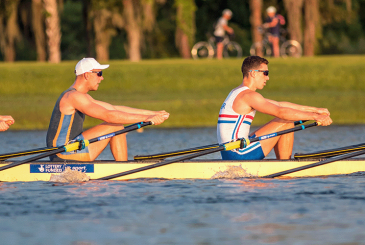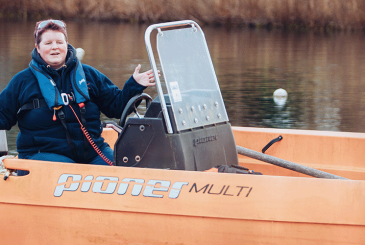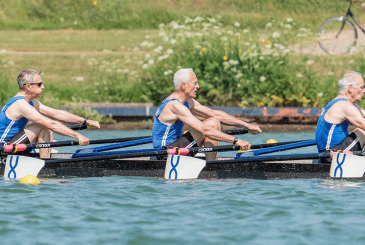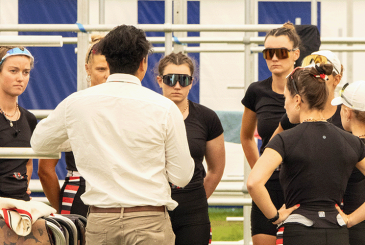The C and D categories for masters women are among the most hotly contested in masters racing. Women in these age groups have built their families and careers and are now finding more time for themselves. Some may be continuing their rowing careers, while others are new to the sport. So what can clubs and coaches do to help get the most out of their 40+ female athletes? Joanne Harris talks to coaches and masters women athletes at two clubs – Broxbourne and Dart Totnes – that are clearly doing this well
Amongst other successes, Broxbourne’s masters women won eights events at the Vesta Masters Head in 2024 and 2023. “We’ve got 25 on our books of whom only five or six have rowed from university or junior level. All the others have come through learn to row,” she says.
The Dart Totnes masters women’s squad has a similar demographic. The group started with some junior parents learning to row while their children were at the club; then a group of eight women asked coach Ian Percy to take them to the next level. The project brought medals at British Masters Championships, and the squad is now a thriving mix of newer and more experienced women.
Where to start: understand your squad
In any group of masters rowers there is likely to be significant diversity in terms of their previous experience and fitness. This is why Broxbourne coach Katie Ball says clubs should understand what they have to work with. They can then shape their programme accordingly, teaching members how to train as well as developing fitness and technique.
Structured training for masters women
Time is of the essence with masters, who are generally juggling rowing with family and jobs, often at a high level. Ball’s philosophy is to use the water for technique and get fit on land. Currently, the Broxbourne squad do one gym session together midweek, either strength and conditioning or on the ergo, and do the other land training in their own time. At the weekend, they row Saturday and Sunday.
Ball says recovery is critical, adding: “Sometimes we have to be quite directive. We’ve moved our training around so we can have designated rest days, and we taper for races.”
She designs her land training sessions to replicate movement in a boat. This type of ‘specificity’ is good practice for all age groups but one adjustment she has made is that there is no jumping, as older joints take less impact than younger ones. Similarly, running should only be an option for land trainingas ‘wear and tear’ rule it out for some who are nevertheless fine to train in other ways.
The Dart Totnes masters squad has a similar programme with land training sessions twice a week and row at weekends. Land training is essentially erging, and they worked out which day most women are able to turn up, and chose that for one of the sessions.
On the water
With limited time available, Broxbourne do a lot of small boats work, which benefits technique and also makes the most of the short stretch available. As captain Claire Wells explains, the concept of a ‘buddy’ system, whereby experienced rowers will coach the less-experienced from the bow of a double or pair, has proved helpful. “There’s only so much of Katie to go around,” Wells points out. “We very much integrate new rowers into the squad now, which historically was quite tricky*. At masters level it takes a long time to improve your skills.”

Percy’s philosophy at Dart Totnes has also been to spend a lot of time focusing on the basics.
“We first tried to build mileage up, a lot of technical outings,” he says. “Getting them to be comfortable in a boat and for the boat to be a comfortable place for them to be: a lot of square blade rowing to get them to use the hands properly. I just made them keep doing it, they hated me for it.
“Once their technique is right we started to build the work in. At first this is lower rate endurance. Then from then we started to build rate.”
*See our article on Managing masters squads with mixed abilities for ideas on how to arrange this.
Challenges of aging
Ball and Percy recognise that women over 40 have particular challenges, including physical changes associated with the menopause. Wells says the Broxbourne women benefit from supporting each other in this area and Ball is good at helping them understand the changes women go through as they age.
“Weight training is really key. The rowers in our squad who don’t do it, you see the muscle mass go. Katie’s really focused on getting us to understand the importance of that,” she adds.
Percy acknowledges that workplace responsibilities can have a noticeable impact for this age group too, saying: “They tend to be a bit more emotional in what happened in the day and bring it to the boat more than juniors or seniors. If the session starts off poorly and they’re not switched on it affects the whole crew.” Technically-complex exercises can help in this situation by demanding full focus in the boat. Examples include pauses (single/double strokes) or alternate feathering and squaring (even on opposite sides in an eight).
Masters rowing – beyond racing
Masters rowing is emphatically not only about racing.
“For me what I’ve got from it is not just the fitness, it’s also the teamwork, having to work out your place in the boat. That’s also helped me in my work,” says Wells. And the enjoyment of being part of a group is what motivates many masters women.
But racing is fun, as the Dart Totnes women found when they started to win. That can feed into a desire to race more, which coaches also need to manage.
“It was quite a journey for them to come from nowhere to there, to the belief that they could win something,” says Percy. Now, Dart Totnes has a bigger squad, as others want to be part of the success, and Percy admits that having to pick crews has changed the dynamic.
At Broxbourne, Ball and Wells acknowledge that with a group of successful, mature women, selection could be an issue. They have navigated this challenge by having one of the more experienced rowers be a part of the process alongside Ball and Wells, as coach and captain.
Benefits of masters rowing to clubs
Encouraging a thriving masters women’s squad can also bring benefits to the club. “We organise a lot of socials, we set up a dinner club once a month, and we painted the changing room,” Ball says.
Even though their time might be squeezed, women in the 40+ age group can bring invaluable career and organisational experience to clubs that rely heavily on the goodwill of volunteers. And, as Dart Totnes has shown, success breeds success and helps grow the size of the group rowing, ensuring a healthy future for the squad.
Photos: Broxbourne RC and Dart Totnes RC










